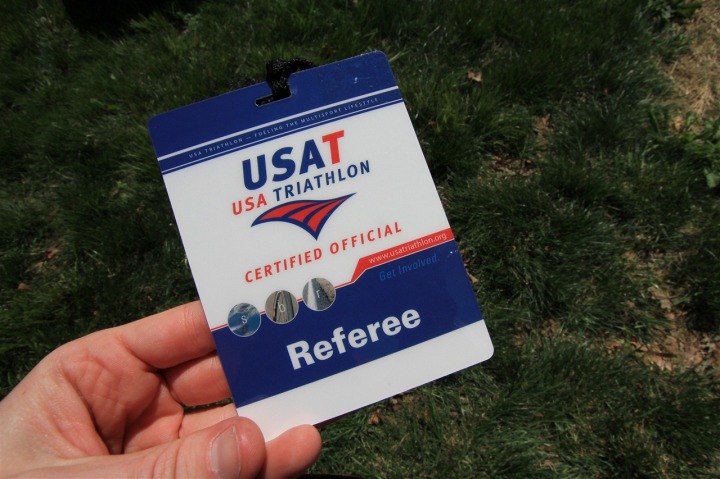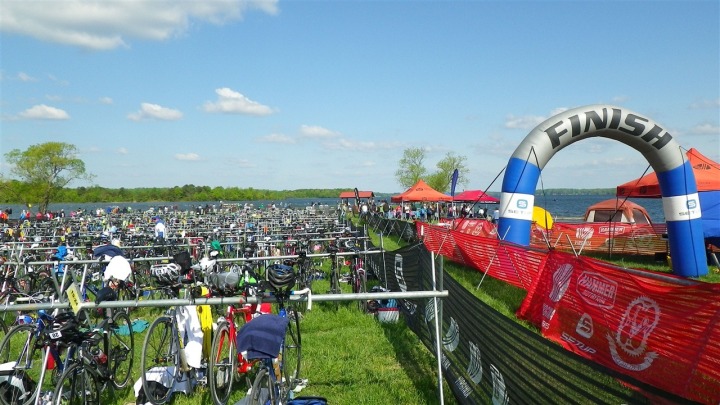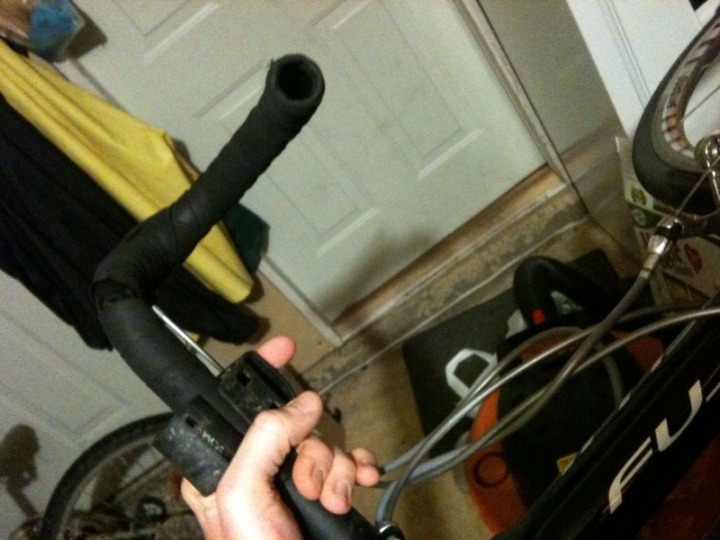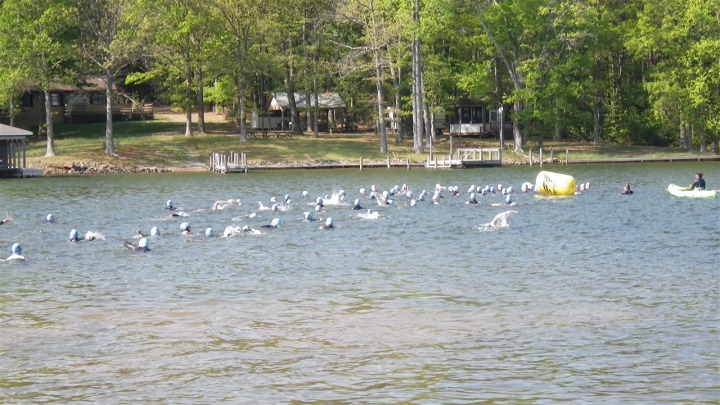In addition to racing this past weekend, I also became a new USAT Certified Official Referee. The process involves wading through an extensive 91 page manual (very in depth by the way, but also fairly well written and easy to follow) on all the sport’s rules, as well as a short clinic, and then officiating a race. Actually, technically I have one more race to officiate. Adam also has a good intro to the hierarchy of officials and the advancement levels.
(Side Administrative Note: I was going to post my race report from this weekend, but the pictures from the race still aren’t up yet, so I’m holding off one more day…)
Of course, with the badge comes a USAT red polo shirt and a hat. The actual black and white striped shirts are saved for the USAT Head Referee – in case you’re curious. So with me, my red shirt, my hat, and a pen and paper pad I set about for a full triathlon’s worth of officiating. But what does that involve – and more importantly – what on earth are the officials looking for anyway?
Well, I’m here to try and break it down – section by section on what the red-shirts are looking for. Or, at least, what I was looking for.
Transition – Pre-Race:
For almost all triathletes there’s probably almost nothing more intimidating than a USAT official snooping around your bike rack prior to the race even starting. After all – it would have a high degree of suck to get a penalty before the gun goes off. Most folks eyed me cautiously, but a few people straight up asked exactly what I was looking for – and so, here you have it, my short list of things I’m validating:
1) Bar ends plugged: I’m simply validating that your bar ends have plugs in them. If they don’t have plugs then you need to get them plugged prior to the race starting, otherwise you can’t race. This is because during a crash, those unplugged bars can take a human core sample from you – which really really really sucks. The good news is that most races simply have a bag of them handy and will plug them. And if all else fails, a quarter combined with some well wrapped tape will suffice as well. Tape alone is not valid however. Just please, get them plugged. For those not quite sure what I’m referring to, here’s a quick picture of one I just popped out of my bike handlebar – note the empty hole:
2) Aero helmets have CPSC sticker: While in theory you would check every helmet for the sticker, in reality it’s pretty hard these days to get a non-certified normal helmet. So the focus is on aero helmets due to an influx a few years back of non-certified helmets that will crack open like an eggshell even when barely dropped. If the sticker is missing (no matter the excuse) – you have to obtain a different helmet to race.
3) No glass: This is simple and logical, but not well advertised. If you have a glass bottle on you, it’s actually grounds for instant DQ. Keep them out of transition and the course. Simple as that.
4) Racked in the correct location: This one is simple as well. Your bike needs to be in the right rack location. If the racks have individual spot labels, then you also need to be on the correct side of the rack.
5) No balloons or markers on your rack: These are considered an unfair advantage, and once transition is closed, they’ll all be removed by the race director. That includes cheerleading pom-poms, pink tape, Spongbob Square Pants Balloons, and anything else creatively tied to the rack marking your spot.
So, in summary – the quick hit-list:
1) Bar ends
2) Aero helmet CPSC stickers
3) No Glass
4) Racked in correct location
5) No unfair advantage items
See, pretty fair and simple and pretty much focused on safety, isn’t it? Good, let’s get racing!
The Swim:
The swim is ‘officially’ the easiest leg for the officials, as there really isn’t a lot to do here. But, there’s pretty much just one thing to be on the lookout for:
1) No illegal swim toys: This means no pull buoys, fins/flippers, gloves, inflated floaties, or anything else that might float you along or propel you faster. However, it should be noted that snorkels ARE permitted in USAT sanctioned events.
Also, note that you are allowed at any point to stop and stand up if the bottom allows, as well as receive assistance from official on-course kayaks, without being disqualified. You just simply need to ensure that if you’re being held up by a kayak, that you’re making no forward progress. The general goal here is that everyone successfully finishes the swim – it’s not really about penalties in the water.
The Bike:
Now that we’re out of the water, the USAT officials take to the back of motorcycles to monitor the progress of the race. We spaced out as evenly as possible, given the number of racers and officials, and then each did two loops on the bike course, at whatever pace we felt necessary.
Once out on the road, I was specifically looking for a few key items. I’ve gone ahead and taken the super-brief description examples directly from the USAT manual, just so you can see what I’m seeing, those are in photo snippets.
1) Drafting/Overtaken: First up – the biggie. By the rules this is when you pull within 7 meters of the rider in front of you and do not successfully make a pass within 15 seconds. It should be noted that the only valid way out of the draft zone is forward. Meaning, you can’t back out and ask for a ‘do-over’ at the 13 second marker. If you fail to make the pass, it’s drafting.
The trick here though is that it’s not as easy as it seems to catch drafters. First, in order to be fair I need to be dead-sure they’re within 3 Bike lengths – or slightly longer than a minivan (about an extra 5-6 feet). Then, I have to start my stopwatch and get to at least 15. But most officials will go a few seconds longer just to error on the side of the athlete.
If the pass hasn’t been completed within that timeframe, a penalty has occurred.
At which point, I have to gather three identifiable pieces of information – such as bike type, color, jersey, shorts, etc… Depending on the race distance, the time penalty will vary, but for an Olympic distance race it’s 2 minutes.
Also, if you don’t fall back when passed, then you can get an overtaken penalty:
Now is a good time to point out appealing penalties. You can appeal any penalty you’d like…but there’s a few penalties where appealing is just a waste of time (and money) – one, for example, being drafting. Drafting penalties cannot be appealed. Simple as that.
2) Traffic Laws (Crossing the Double Yellow Line): This one is simple – please don’t cross the double yellow line. If you do, and the course hasn’t specifically permitted it (such as a fully closed course), then it’s a penalty. As I raced the day before I saw some pretty brazen yellow-line moves resulting in near accidents with cars and farm equipment – even on blind corners. Remember, you may be able to dodge the car, but the car may decide to turn into your fellow athletes out there – endangering or killing them.
3) Blocking & Position: Blocking is when you’re impeding another athlete’s forward progress on the course. Similarly, it’s also illegal to hang out on the left side as well, even if you didn’t pass anyone – that’s a position penalty. Virtually everyone has been in the situation where the (slower) cyclist in front of them just sits in the left side blocking a pass. If you went to the right, then you’ll get a penalty for passing on the right (which I’ll talk about in a second).
4) Abandoned Equipment (Garbage tossing): If you toss garbage, you’ll get a penalty. If your water bottle drops out of your hands and onto the ground, and you don’t go and pick it up – you’ll get a penalty. If the gel wrapper flies out and you don’t get it, you’ll get a penalty. This is super simple – leave nothing behind – just like wilderness camping. If it drops, go get it – that’s the only way out of the penalty. The only valid place to drop garbage is at designated garbage dropping locations near water stops, which are usually only on half-iron and longer courses.
5) Passing on the right: Not as well known, but is illegal to make a pass on the right. The person on the left that’s blocking the way can indeed be charged with a blocking or position penalty (per above), but if you go and pass on the right, then you’ll get charged with a passing violation.
Now, there’s a slew of other little rules you can get hit with on the bike, but these are the big ones that folks are focused on. And there are also different rules for both pro races and ITU races. And WTC events have a slightly tweaked list as well. You can see the form below listing some of the different penalties for a standard USAT race though. This is the form I have to fill out for each penalty.
The Run:
On the run, the number of penalties you’ll run into (no pun intended) is significantly reduced. And the likelihood of committing them is pretty minimal. That said, here’s what I’m looking for:
1) iPods and the like: The rules are simple here – if you have an MP3 player or other ‘Unauthorized accessory’ – including a hard cast – then you can get a penalty. I know it sucks for those that really like listening to music on the run, but it is considered an unfair advantage by USAT, and thus banned.
2) Authorized assistance (pacing): Basically, you’re not allowed to have folks pace you on the run. Be it a friend running alongside, or a bike pacing alongside. Both can result in you getting a penalty. This is especially well enforced at the longer distance events like half-iron’s or Ironman races where friends and family want to run alongside. Ensure you inform your BFF’s that they cannot go for a stroll with you during the race.
3) Abandoned Equipment (throwing trash again): Just like on the run, if you toss garbage, you get a penalty. Just keep it to the aide station and you’ll be fine.
See, like I said – the run is pretty harmless for the most part!
Summary:
Without a doubt, being a Referee is a great learning experience – and a great way to better understand the sport and both sides of the race. I think if everyone had to ref one race, races would probably be a fair bit cleaner, and people might avoid penalties. As a racer I know you get into that zone during a race and sometimes time and space sorta gets a bit fuzzy. But the bulk of the USAT rules are simply there to keep you and other competitors safe. And the remaining rules are to ensure a fair race.
Simple enough, eh?
FOUND THIS POST USEFUL? SUPPORT THE SITE!
Hopefully, you found this post useful. The website is really a labor of love, so please consider becoming a DC RAINMAKER Supporter. This gets you an ad-free experience, and access to our (mostly) bi-monthly behind-the-scenes video series of “Shed Talkin’”.
Support DCRainMaker - Shop on Amazon
Otherwise, perhaps consider using the below link if shopping on Amazon. As an Amazon Associate, I earn from qualifying purchases. It doesn’t cost you anything extra, but your purchases help support this website a lot. It could simply be buying toilet paper, or this pizza oven we use and love.















![image[44] image[44]](https://media.dcrainmaker.com/images/2010/04/thoughts-from-a-new-usat-referee-orwhat-im-looking-for-29-thumb.png)























As always great post! On the blocking thing, if you are riding and someone is hanging in the left side not allowing you to pass on the left, is there anything you can do besides yell “coming on your left”. If they do not move over and I pass on the right will I still get penalty even if the usat saw the person was not moving over? Can the Usat official use their judgement to let that go?
Congrats on the certification, and great post of all the rules!
How many events do you plan on officiating vs. participating in???
I know this has been a widely debated topic but I think headsets should be banned at all “official” races and runs. If not for that participants safety than for the safety of others. Keep it to the training and warm-up, go USAT!!!
Ray, congrats! That’s very exciting and I didn’t know all the rules myself. Way to be a well-rounded ambassador for the sport 🙂
Thanks for all the great information! I am very impressed that you are a ref now. I hope you enjoy the gig!
Congrats on the certification!
Can you tell me if it is illegal to use the pacing function on the garmin?
Ray, this was a very interesting, enlightening post.
I have a question. I recently began using a Wetronome for swimming in the pool( link to wetronome.com ) which puts out a steady beep in my ear to help me with swimming cadence.
Could I use this in a race?
great write up.
should be required reading for many!
I need to get me one of those badges, because they must have recently started giving them away…it makes an official seem even more…official (as if the short and hat weren’t enough).
I’d encourage anyone who is posting questions to read the rules themselves, because most of the answers are all there and you will learn a lot in the process.
link to assets.usoc.org
In cases where it is not explicitly stated (ie wetronome, unique situations of passing), it is the official’s/head referee’s judgment call as to whether or not it is an unfair advantage or an illegal maneuver. We try to do our best to see everything, but of course, it has to be observed first by an official in order to be written up.
Great post! I will be printing this off to hand out to my crew that I am coaching. They have a sprint this weekend.
Very informative post! Thanks for enlightening us!
Wow, that’s awesome!! You certainly should haven an edge when racing now that you really know all the rules. I’m excited to hear about the races you referee for as well!! We can call them Referee Race Reports or R cubed.
Excellent post Ray! Very informative …. all the RD’s should print this out for every triathlete to read!
To answer a few questions…(though Adam answered a number already)
Whitarican-
Funny you asked, I actually asked the exact same clarificaiton quesiton during the classroom portion. The answer in short was that quite simply you have to wait…and yup it sucks. At least, that’s the only ‘legal’ way. Yelling is pretty much your best option.
Mike-
I’m not sure exactly yet. Maybe one every month or so. I don’t want it to impact my training schedule, so I’m looking to do races that compliment it well (meaning, I can find a good place to get my runs/rides/swims in post-race).
Hi MWhitely1-
The pacing function on wrist watches such as the Garmin’s are OK. See the link below for a bit more clarification.
Hi Al-
During the swim you are not permitted any audio device on your head. Charlie – the head USAT ref – clarified this recently on the Slowtwitch forums, citing exactly the scenario you noted, as well as covering pacing devices in general – see this:
link to forum.slowtwitch.com
Thanks all for your comments!
The rule about “the only way to exit the draft zone is to complete the pass” sounds sucky if the guy you are trying to pass takes it as an opportunity to put on a surge, thus stopping you from completing your move.
He is in the clear (not blocking or anything) and you can get penalized.
Hmmm.
You have given me cause to re-read our local (Australia) rules (which are only 20 pages or so long) and they state a similar thing re forward progress must be made at all times when your draft zone overlaps the dude in front.
That said, in anything other than state/national title races or long course/Ironman events the officials are good and will tell athletes what to do (without recording a violation) for most of these infringements.
Great post.
Thanks DC.
At Chicago tri you pass on the right, ride on the left
Congrats on becoming a USAT ref!
This is something I’ve thought about doing in the future as I think the number of refs in Hawaii are limited. I didn’t know about the ballons & markers not being allowed, though. I’ve actually seen some races that cater to first-timers encourage them!
I starred this one a while ago, and I’m glad I came back. Very interesting read, especially with some of the particulars I wasn’t aware of. Cool stuff.
Congrats on the certificaation!
May you use a cellphone or walkie-talkie to call or text someone during a race?
The purpose of this would be to update my family to my progress so they can see me instead of my wife having to sit with several small kids for hours in the heat for the chance to see me passing by. If I could call or text her my location on the course it would make things much easier for my “fan club” by making the meetings much more coordinated.
Great explanation of the USAT Competitive Rules and what we do.
One clarification you may wish to make is in your description of drafting as being “when you pull within 7 meters of the rider in front of you.” This does not accurately describe the USAT definition of a draft zone.
Within 7m suggests that you were closer than 7m from the athlete in front of you, whereas USAT defines the draft zone as starting at the leading edge of the front wheel of the bike. I can be within 7 meters of the bike in front of me and not be in their draft zone, meaning I can ride there all day long without risk of penalty.
the rules clearly state that a right hand pass is allowed when someone is blocking on the left, “AND the notation that there was room on the left for a proper pass”
this isn’t debatable
Nice post! Some of my own comments…
Whitacarian – It’s probably cold comfort to know the person who is blocking is most likely going to get a penalty, too.
Hank – that answer is “no.” Competition Rule 3.4k states that no participant shall use equipment which “might provide an unfair advantage or endanger other participants.” The walkie-talkie or cell phone could also be used by someone to provide you pacing information throughout the run. Someone along the side of the road telling you the time deficit to the next guy in your age group is fair, “ongoing tactical counsel” is not.
t – Competition Rule 5.10e states a participant must not attempt to pass another cyclist unless adequate space is available and the athlete is confident of his/her ability to pass the other cyclist. All passing is to be done to the left of the cyclist being overtaken unless otherwise specified. The only specification is when race management states riding will be on the left and passing on the right, such as in Chicago (mentioned by Matias).
The drafting rules in the USAT are horrible, especially in large wave starts you end up having to pass lots of people who don’t merge right or large groups of similar riders bunched together at the start. I’ve just given up trying to follow the rules and maintain a “spirit of the law” approach. I stay out of the draft even if that only means out of their direct line; which is technically drafting but I’m not getting any advantage. Sure it was disappointing seeing a 5+ pace lines pass me in the last 70.3 ride but as you said the worst they’re going to get is a 4 minute penalty. What’s worse is officials tend to ride the course in the direction of the ride so as long as your not the last one drafting you’re not going to get caught.
Trying to maintain a 22mph pace in the last race I did I came up to 2 people riding abreast from a previous wave. They wouldn’t move over at 16mph and I had no way to pass and I got called for drafting! The official said I need to wait for the pass..which wasn’t going to happen because they were talking to each other. There’s no recourse for the drafting and I was drafting at 16mph almost 6 miles slower then my planned pace. Oh and the rider in front didn’t get a penalty. The bike rules need to be reevaluated or enforced differently; I agree with all the other rules. Maybe have officials ride the course on bikes with cameras.
Oh yeah and what’s up with the penalty tents? Just take off the time from the contestants overall time. A rest if almost an award that benefits most people; except for the Pro/Top finishers.
Indeed, congrats on the certification, and one more outstanding article.
Page virus!
Hey, is it me, or perhaps a false-positive from Kaspersky? In “Related Comments” above, Kaspersky has blocked logo images #1, 2, and 4 from “deepwish.com” as Trojans. These would be the IMAGES used for the “Thoughts on Triathlon Bike Penalties”, “Thoughts on USAT Race Official Staffing”, and “15 Must-Read Posts For New (And Vintage) Triathletes”
Hi Don-
Thanks for the heads up. Wasn’t actually a page virus, but rather, just a cross-site error that you received from a bit of leftover code pointing to a rotating dev site used. Just cleaned it up with a placeholder image…for no image…on related posts.
Cheers!
Thanks Rainmaker! I appreciate your diligence in all of this stuff – and had thought that there was a high likelihood of something like that. Feel free to delete this post. Hey, quick question while I’m here (and I’m returning today to make sure I read it right): As a referee, you would have no problem seeing a snorkle? I saw my first one in St Anthony Tri (here in St Pete, FL) this past weekend. –And the question that the search engine brought me here for was for bike positioning. I racked my bike, this weekend, on the correct side, but by the brake levers instead of the seat, putting the rear wheel down, instead of the front. The guy next to me fussed with me mercilessly as it had to be “front wheel nose down”. I’m 6’2″, and my seatpost is too high without having to twist the bike to get it out in that way, so I thought I had a solution — until my “Hey, I don’t make the rules”. But then, I think I found out that I AM acceptable in that way, Rule, by my reading is “correct side” — either front OR rear wheel down.
Again, thanks for all, and a diligence to this issue. And congrats on the move to France!
Technically speaking, I’d have to allow the snorkel (as much as it pains me…).
Congrats on the race! Funny, had I actually realized that St. Anthony Tri was the same time I was down there (more than a week ahead of it), I probably would have raced for fun.
Thanks for the comment and candor. Yeah, I suppose that speaks what I was feeling without verbalizing it. Perhaps I’ll buy a snorkel and use it to train for pacing and rhythm, and then plan on going “purist” on race day. It will be an interesting scenario though as, if it’s in the books as OK, more and more of this will likely be seen.
St Anthony is a great race. Well organized with great people. The other one I like locally is Longboat Key (next weekend, and in October) — reportedly the best after-food on the circuit.
Thanks again for the great site, and the comments on this stuff.
The issue with USAT Officials and the Official’s Program in general is three fold.
1.) The program is administered by one person who is not fair nor equitable in his administration. Nor is he consistent in his interpretation of the rules or his ruling when faced with adversity from athletes filing complaints or other issues that threaten his position.
2.) USAT Officials are not trained well. The program is set up as a part time volunteer avocation. You are, instead of a weekend warrior Triathlete, now suddenly a weekend warrior Official expected to interpret the rules correctly time after time from your first time on the back of a motorcycle. It’s impossible. So many mistakes are made, it’s laughable at best.
3.) The rules are not applied to every athlete the same way. Some officials do not call drafting when they see it because they are unsure of the situation, and others call it unfairly because they have not properly observed the situation that put the athletes into a position of unavoidable drafting. Some Officials think they are police officers and their job is to crack the knuckles of any poor weekend Triathlete that crosses their path. Others turn a blind eye to blatant rule infractions because they are afraid of the consequences if the athlete should file a protest or complain to USAT that they were treated unfairly.
Until the program has a decent foundation and a Commissioner that is competent, it is quite simply a feel good band aid on the sport.
Then what’s your solution?
Racers make the best referees having been under race conditions themselves.
Generally most of athletes abide by the
rules and it’s usually not a problem.
Except for those that think it’s only a penalty if you get CAUGHT!